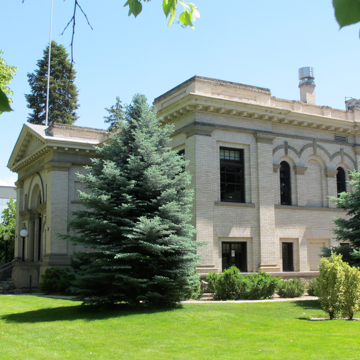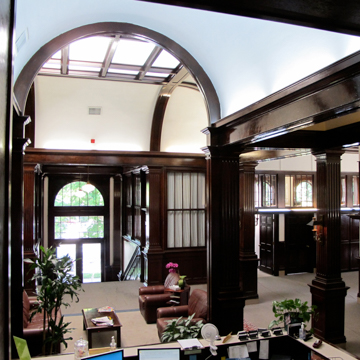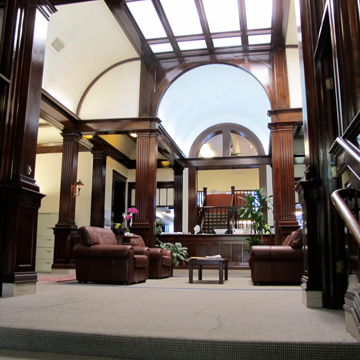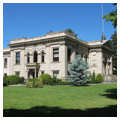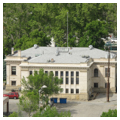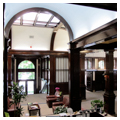You are here
Huntley Law Firm
The first of eleven Carnegie libraries built in Idaho, this elegant Renaissance Revival building is located on the north edge of downtown Boise. The building was sited on an entire half block that gave graceful and pleasing views to passersby on both the busy Eighth Street corridor and Washington Street. Along with the capitol and the nearby Boise High School, this library is an exemplar in Boise of the Classical Revival popular in the United States between 1890 and 1920. By 1904, the City of Boise had grown to 6,000 inhabitants and was beginning to cherish the idea of a city of culture. Just three years later, Clarence Darrow called Boise City the “Athens of the Sagebrush.” In 1902, the state library commission requested a grant from Andrew Carnegie, who gave the city $20,000 for a new library, making it the largest grant given to any Idaho city. The City of Boise donated $4,000 more, and the local Columbian Club added $1,000. The Boise school board donated the ample site, just across the street from the high school and one block from the soon to be built State Capitol. These buildings together formed a nucleus for Boise’s City Beautiful core.
Boise citizens and the Columbian Club, local women commissioned by Governor Norman Willey to help prepare Idaho for the 1893 World’s Columbian Exposition in Chicago, hoped this new library would be a totally local endeavor. Nonetheless, the competition to design it was open to architects from outside Idaho and it attracted seventeen proposals, including a well-received entry from C. Z. Hubbell of Spokane, Washington. After much discussion, however, the scheme from local architect John E. Tourtellotte won out over that of Hubbell. This decision was informed by more than local pride: Tourtellotte had been practicing in the Boise area since 1896 and already had numerous residences, schools, and churches on his resume. The library group had selected a firm that would become the most significant architectural firm in Idaho’s history.
A construction contract was awarded to Michels and Weber, a local company. The library was built using locally fired white bricks and elements of local Boise sandstone. While many of Tourtellotte’s earlier projects were either more picturesque or often showed Romanesque qualities, the library’s classical design showed a discipline and sophistication that was new in the firm’s work. Tourtellotte would continue in this vein, creating in the Idaho State Capitol (1905–1920) his firm’s largest and most noteworthy classical buildings. At the library, Tourtellotte’s Palladian front entry remains one of the most sensitive classical efforts in Idaho.
The classical front entrance is approached by six stairs, which proceed through a tall arched opening flanked on each side by Etruscan columns. A simple pedimented gable sets off the entry. The pediment is adorned with dentils, which continue around the entire building as part of a clearly defined cornice. Flanking each side of the entry bay are triple round-headed windows gracefully connecting the rectilinear corner bay and its rectangular window. Brick pilasters are seen on both sides of the entry bay as well as at the corner bay of the building. These elements provide a fine array of shadows on the exterior of the building. A rusticated stone band was used as trim over the round-headed windows and as sills for all windows.
On May 1, 1905, a grand ball was held, and the public arrived for tours of the new Progressive Era library. Judge C. G. Goodwin from Salt Lake was the main speaker, with others sharing the platform. All, of course, were lavish in their praise of the new library and its effect on the growing city. For seventy years, the library served the City of Boise and especially students of nearby Boise High School. By 1973, Boise’s population had grown to more than 75,000 and a new and larger library was long overdue. The city library moved sixteen blocks north to a much larger but less impressive building on Capitol Boulevard. The 1904 library was repurposed as a law office and is, at the time of writing, owned by the Huntley Law Firm. The interior spaces of the library have been carefully restored, and this most skillfully wrought neoclassic gem continues to grace the City of Boise.
References
Hart, Arthur A. Historic Boise, An Introduction to the Architecture of Boise, Idaho, 1863-1938. Boise, Idaho: Historic Idaho, Inc., 1993.
Neil, J. Meredith. Saints and Oddfellows, A Bicentennial Sampler of Idaho Architecture.Boise, ID: Boise Gallery of Art Association, 1976.
Renk, Nancy, F. “Carnegie Public Library,” Ada County, Idaho. National Register of Historic Places Inventory-Nomination Form, 1974. National Park Service, U.S. Department of the Interior, Washington, DC.
Idaho Statesman, February, 2 1904 through May 4, 1905.
Thomason, Frank. Images of America Boise.Charleston, South Carolina: Arcadia Publishing, 2009.
Wells, Merle, and Arthur A. Hart. Boise, An Illustrated History. Sun Valley, CA: American Historical Press, 2000.
Wright, Patricia, and Lisa B. Reitzes. Tourtellotte and Hummel of Idaho, A Standard Practice of Architecture. Logan: Utah State University Press, 1987.
Writing Credits
If SAH Archipedia has been useful to you, please consider supporting it.
SAH Archipedia tells the story of the United States through its buildings, landscapes, and cities. This freely available resource empowers the public with authoritative knowledge that deepens their understanding and appreciation of the built environment. But the Society of Architectural Historians, which created SAH Archipedia with University of Virginia Press, needs your support to maintain the high-caliber research, writing, photography, cartography, editing, design, and programming that make SAH Archipedia a trusted online resource available to all who value the history of place, heritage tourism, and learning.




